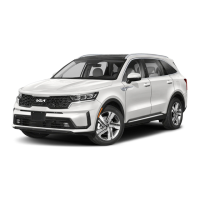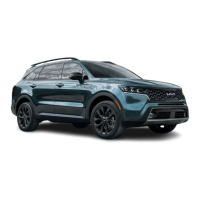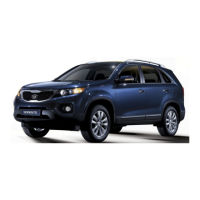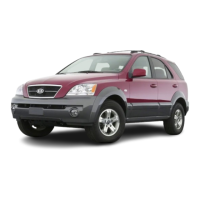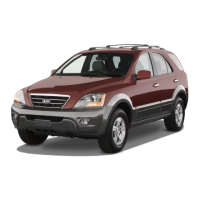15
5
5
Driving your vehicle Automatic transmission (Shift Lever)
Good driving practices
僅 Never move the shift lever from P
(Park) or N (Neutral) to any other
position with the accelerator pedal
depressed.
僅 Never move the shift lever into P
(Park) when the vehicle is in motion.
僅 Be sure the vehicle is completely
stopped before you attempt to shift
into R (Reverse) or D (Drive).
僅 Never take the vehicle out of gear and
coast down a hill. This may be
extremely hazardous. Always leave
the vehicle in gear when moving.
僅 Do not "ride" the brakes. This can
cause them to overheat and malfunc
-
tion. Instead, when you are driving
down a long hill, slow down and shift
to a lower gear. When you do this,
engine braking will help slow down
the vehicle.
僅 Slow down before shifting to a lower
gear. Otherwise, the lower gear may
not be engaged.
僅 Always use the parking brake. Do not
depend on placing the transmission in
P (Park) to keep the vehicle from
moving.
僅 Exercise extreme caution when driv
-
ing on a slippery surface. Be espe
-
cially careful when braking,
accelerating or shifting gears. On a
slippery surface, an abrupt change in
vehicle speed can cause the drive
wheels to lose traction and the vehicle
to go out of control.
僅 Optimum vehicle performance and
economy is obtained by smoothly
depressing and releasing the acceler
-
ator pedal.
僅 When driving uphill or downhill,
always shift to D (Drive) for driving
forward or shift to R (Reverse) for
driving backwards, and check the
gear position indicated on the cluster
before driving. Driving in the opposite
direction of the selected gear can lead
to a dangerous situation by shutting
off the engine and affecting the brak
-
ing performance.
僅 Always buckle-up! In a collision, an
unbelted occupant is significantly
more likely to be seriously injured or
killed than a properly belted occu
-
pant.
僅 Avoid high speeds when cornering or
turning.
僅 Do not make quick steering wheel
movements, such as sharp lane
changes or fast, sharp turns.
僅 The risk of a rollover is greatly
increased if you lose control of your
vehicle at highway speeds.
僅 Losing control often occurs if two or
more wheels drop off the roadway
and the driver oversteers to reenter
the roadway.
僅 In the event your vehicle leaves the
roadway, do not steer sharply.
Instead, slow down before pulling
back into the travel lanes.
僅 Never exceed posted speed limits.
If your vehicle becomes stuck in snow,
mud, sand, etc., then you may attempt
to rock the vehicle free by moving it for
-
ward and backward. Do not attempt this
procedure if people or objects are any
-
where near the vehicle. During the rock
-
ing operation the vehicle may suddenly

